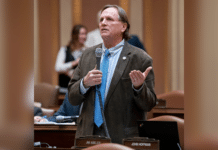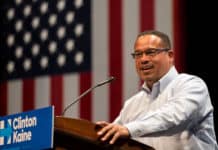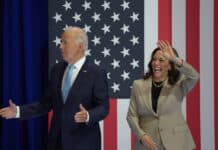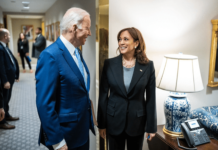(American Greatness) — I was in a seaside resort town in Brazil a few years ago. While there, I developed a rapport with a former fashion model, with many interesting stories, who happened to own the bed and breakfast where I was staying.
One story was about how her father would make her give him most of her earnings for safekeeping. He converted them to dollars and stuffed the cushions and pillows of their couch with them, along with most of his earnings and her mother’s earnings as well. She and her mother thought he was crazy. Most of the people they knew also thought he was crazy. He was constantly ranting about inflation and how economic disaster was looming.
Then one day in March of 1990, the day after Fernando Collor de Mello was inaugurated as president of the Republic of Brazil, Brazilians awoke to find their bank deposits frozen. No one could withdraw money. Everyone with more than $1,250 in their bank account was told that the government had “borrowed” their money and wouldn’t give it back for 18 months. Nearly $46 billion sucked out of the nation’s economy in a single stroke. As word spread across town of what was going on, the father burst into the living room with a knife. He wildly slashed open couch cushions and began throwing $100 bills into the air and laughing maniacally “who’s crazy now?”
As the woman finished this story she pointed to her beautiful villa perched on a bluff overlooking the ocean, in the best neighborhood in one of the poshest towns in the Western Hemisphere, and said “my crazy father was the reason I was able to buy this place with the money I made from one Calvin Klein shoot.”
For most of my lifetime, inflation has been an almost imperceptible phenomenon in America. Prices rose so gradually that they were unfelt, noticed only when coming across a receipt or price tag from several years prior. Typically inflation has tracked around the Fed’s two-percent target. That has all changed since the orgy of government pandemic spending, and the money printing it requires from the Federal Reserve began to show up at the register this year. The rate dramatically ticked up in November, with an annualized Consumer Price Index increase of 7.1 percent. And that is a rigged estimate.
The methodology of the Consumer Price Index used to be a fixed basket of goods, now the basket is dynamic, allowing them to take out goods that increased significantly in price and replace them with substitutes that have more modest price increases or even price declines. According to economist Peter Schiff, the original CPI methodology would today show an inflation rate of around 15 percent.
Inflation has become a major problem for Americans and has now overtaken COVID-19 as their top concern. Democrats didn’t take it seriously as the rise in prices became evident over the summer. Instead, they assured us that it was “transitory.” But it has only worsened month after month. I believe it was one of the key sleeper issues that led to a Republican resurgence in Virginia’s elections (Glenn Youngkin ran on eliminating the grocery tax), particularly among Latino voters who know from experience the misery of inflation, something that Latin American countries have struggled with for decades. But we are nowhere near the peak of inflation, in fact we are accelerating, as evidenced by the nearly 10 percent increase in the Producer Price Index, which takes about six to 12 months to show up in consumer prices.
Inflation will be a problem that will have to be battled for at least the next couple of years if not longer. There are signs that the Federal Reserve and some Congressional Democrats like Joe Manchin are taking steps to avert further damage, but any change in monetary fiscal policy will take roughly twelve to eighteen months to show up in consumer prices and we have not yet priced in all of the inflationary costs of pandemic spending or any of the spending bills passed by this Congress. There are internal concerns that by summer of 2021 we could see inflation as high as 35 percent over 2020.
The wealthy hold assets and debt so they’re relatively protected, but the middle and working classes face penury. Remember the World Economic Fund slogan “You Will Own Nothing and Be Happy”? That dystopian vision is what runaway inflation is accelerating us towards. Wage workers won’t be able to afford down payments on property, credit will be tightened and rates will be raised to combat inflation. Farms will go out of business en masse like they did in the late 1970s and early 1980s when consumer interest rates hit 20 percent. Inflation is a pernicious tax that you can’t hide from the IRS—it’s exacted from anyone who holds the U. S. dollar.
A recent article in Bloomberg discussed coping strategies, one was “spend your paycheck right away.” This will happen. As the value of the dollar decreases, people will be less willing to hold dollars, choosing instead to spend them before it takes more of them to buy the same thing. This has the effect of increasing the amount of money in circulation—a phenomenon known as monetary velocity—which further drives up prices and drives down willingness to hold dollars.
Uncontrolled inflation is no mere annoyance; it is a disease that turns every single day into a fight for survival. It brings out the worst in people. And it makes our politicians even more absurd. When egg prices rose during the Vietnam era, for example, President Johnson had the surgeon general issue alerts as to the hazards of cholesterol in eggs in an effort to reduce demand for them and thus their prices. That myth continued beyond that inflationary period and has caused residual damage to the health of tens of millions of Americans.
Venezuela was once the pearl of the Caribbean. It was a prosperous First-World country as recently as the early 1990s. Hyperinflation reduced it to a living hell, with many children starving to death and others left crippled by malnutrition, leading to their bones dissolving for lack of calcium. Desperate parents gave away their children, in some cases to child sex traffickers, just in hopes that someone would feed them. In 2017, the average Venezuelan lost 24 pounds. It’s not just consumer prices that are disrupted by inflation, but the entire production and supply chain. Venezuelan hospitals ran out of medicine, supplies, and finally, water and electricity. In response, the government finally allowed an alternative currency to be used: the dollar. Dollarization has led to an overnight improvement, with most Venezuelans finally able to at last buy groceries and medicine.
Fortunately we are still a ways off from Venezuelan-level inflation, but that is where we are headed if we continue the reckless policies that have reintroduced the experience of inflation to the American consumer. And there are few easy ways to get control of inflation and all of the options are politically punishing. President Carter took on stagflation with cuts to government spending and the appointment of inflation-hawk Paul Volcker as Fed chairman. The strategy worked, but it was economically painful in the short-term, causing a recession. The rising unemployment from recession worked to Reagan’s electoral advantage and Carter’s austerity measures cost him re-election. It is a lesson that Democrats have never forgotten.
The Federal Reserve’s hands are tied, as evidenced by their decision to keep interest rates between 0.00 percent and 0.25 percent, even while removing “transitory” from their vocabulary. Increase interest rates quickly and significantly enough to curb inflation and the entire market melts down along with the federal government’s fiscal budget. Despite historically low interest rates, the federal government is projected to have spent $300 billion this year on interest payments on the national debt. Even a mild increase in interest rates would increase government expenditures on interest payments by hundreds of billions of dollars. Fed Chairman Jerome Powell faces a Sophie’s Choice scenario: continue to allow inflation to spiral out of control by keeping interest rates low—which would result in all manner of civil unrest and possibly even a real insurrection—or raise interest rates, which would crash the stock market and force Congress to cut spending, ensuring the complete and total destruction of Congressional Democratic majorities, the likes of which the country has never seen.
Adding to the complexity and severity of our problem is the dollar’s status as the dominant reserve currency of the world. It backs all but a handful of other currencies around the globe and as such, its depreciation can lead to depreciation of other countries’ currencies, compounded by those countries’ own central bank inflation. The reserve currency status of the dollar is chiefly responsible for America’s standard of living being as high as it is. The entire American economic model is built on the dominance of its currency. We are able to sustain a perpetual trade deficit with the world because of it. We export dollars and we get cars and electronics and food in return. On the fiscal side, inflation is a tax paid not just by Americans who hold dollars, but by dollar-holding foreign countries, companies, and citizens as well.
Countries tolerate this trade-off because of the anti-inflation credibility built over the past 40 years by hawks at the Fed like Paul Volcker. But the irresponsible fiscal and monetary policies carried out in the last two years by the American government is destroying that credibility and governments the world over are looking for alternatives to the dollar. If the dollar loses its dominant reserve status there will be a massive and painful reordering of the American economy in addition to the effects of the inflation itself and the policies that will be undertaken to deal with the inflation. In effect there are three layers to the looming economic disaster: inflation itself, with all of its miserable effects; anti-inflation policies like rate hikes, which are highly disruptive and economically painful; and the move away from the dollar as reserve currency, which will transform the American economy and global economic order to a degree not seen since the World War II.
Lenin said that if you wish to destroy a nation you must corrupt its currency. Whether this has happened as a result of accident or design, I cannot say. It was not for nothing that the World Economic Forum last year unveiled their vision of what your life will look like in the year 2030: “You will own nothing and you will be happy.” The more 3D printed suicide pods I see the less I believe in mere coincidence. What I do know is that the ultra-wealthy and the banks have the most to gain from this and they are the ones who have most encouraged the policies that have brought us to this. It seems that they are well-positioned to buy up the remaining assets of middle and working class Americans at fire sale prices, after they have finished setting fire to the economy. But then again, it could just be incompetence. That is one commodity that there is no scarcity of among those who occupy the commanding heights of power in America.
One thing I can say with confidence is that the government will not act. It will do too little, too late. There isn’t the courage left in our political class to make hard decisions. There are no more Jimmy Carters. We have to begin thinking about what comes next.


















